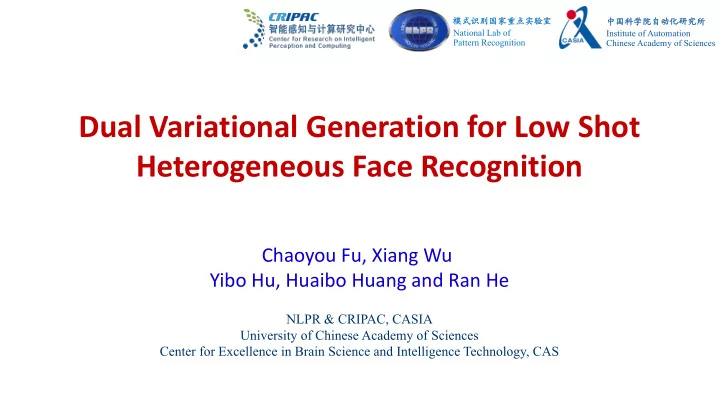

模式识别国家重点实验室 中国科学院自动化研究所 National Lab of Institute of Automation Pattern Recognition Chinese Academy of Sciences Dual Variational Generation for Low Shot Heterogeneous Face Recognition Chaoyou Fu, Xiang Wu Yibo Hu, Huaibo Huang and Ran He NLPR & CRIPAC, CASIA University of Chinese Academy of Sciences Center for Excellence in Brain Science and Intelligence Technology, CAS
Heterogeneous Face Recognition ● Diverse modalities NIR Thermal Sketch ID Card Video Profile ● Broad applications Mobile Phone Criminology Surveillance Gate
Heterogeneous Face Recognition ● Challenges in HFR Ø Large domain gap between heterogeneous data Ø The lack of large-scale databases ● Generative model for HFR Ø Conditional image synthesis - translate NIR to VIS to reduce domain gap Ø Unconditional image synthesis - generate images from noise Conditional Synthesis Unconditional Synthesis Noise Input NIR Synthesized VIS Synthesized NIR and VIS
Conditional Image Synthesis ● Two challenges of such image-to-image translation methods Ø Diversity: Limited number of images and intra-class diversity Ø Consistency: Difficulty in preserving identity Input NIR Synthesized VIS G Only synthesize one new image of the target domain with same attributes It is challenging to guarantee the identity consistency Same identity ?
Dual Variational Generation ● Generate paired new heterogeneous data from noise Ø Sample large-scale new images with abundant intra-class diversity Ø Ensure the identity consistency of the generated paired images Same identity Abundant intra-class diversity Large-scale new images
Dual Variational Generation ● Training method Ø Learn the joint distribution Ø Align the distributions Ø Preserve pairwise of paired data via Wasserstein distance identity via 𝐺 "# Training Framework Testing Framework
Experiments NIR-VIS Ø CASIA NIR-VIS 2.0 database Ø BUAA-VisNir database Ø Oulu-CASIA NIR-VIS database Baseline: VR@FAR=0.1% = 97.4% Baseline: VR@FAR=0.1% = 89.4% Baseline: VR@FAR=0.1% = 68.3% DVG: VR@FAR=0.1% = 99.8% DVG: VR@FAR=0.1% = 97.3% DVG: VR@FAR=0.1% = 92.9% Improving 2.4% Improving 7.9% Improving 24.6%
Experiments Thermal-VIS Sketch-Photo Profile-Frontal Face Ø Multi-PIE database Ø IIIT-D Viewed Sketch database Ø Tufts Face database Baseline: Rank-1 = 65.4% Baseline: VR@FAR=1% = 81.04% Baseline: Rank-1 = 37.5% DVG: Rank-1 = 83.9% DVG: VR@FAR=1% = 97.86% DVG: Rank-1 = 53% Improving 15.5% Improving 16.82% Improving 18.5%
Poster: 05:30 -- 07:30 PM @ East Exhibition Hall B + C #66 Code is released: https://github.com/BradyFU/DVG
Recommend
More recommend